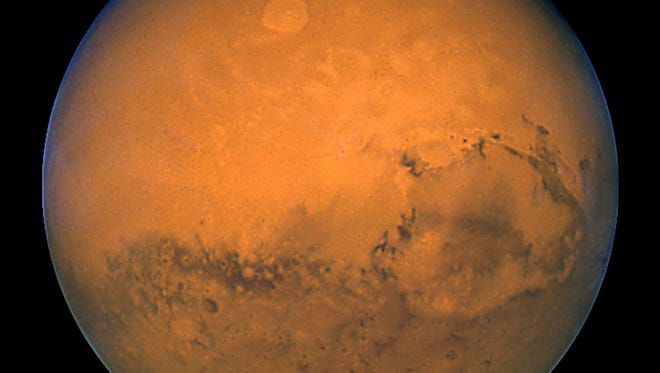Trump budget keeps NASA mostly intact but jettisons a few Obama priorities

WASHINGTON – This is no longer Obama’s NASA.
Even though the space agency would get roughly the same $19 billion it received this year, key programs the former president championed – an asteroid mission, several climate change research projects, robust education outreach – would disappear under President Trump’s budget for 2018.
The most high-profile missions remain on target: the continued development of the Space Launch System and Orion vehicle intended to take astronauts to Mars by the 2030s, the launch next year of the James Webb Space Telescope, and the use of private companies to keep delivering cargo and – possibly by the end of 2018 – humans to the International Space Station from American soil.
“What this budget tells us to do is keep going, keep doing what we’ve been doing,” Acting NASA Administrator Robert Lightfoot said Tuesday in a speech to agency employees.
In a $4.1 trillion federal budget proposal that saw some agencies slashed by 10% or more, NASA fared well. The $19.1 billion it would get is about 3% less than the amount Congress appropriated for the current year. And it’s likely lawmakers will make more changes as the budget process unfolds.
It’s unlikely, however that the asteroid mission unveiled under Obama as part of a pathway to Mars will get revived. The Asteroid Redirect Mission, panned roundly by Republican lawmakers, would have corralled a piece of an asteroid and brought it into lunar orbit as a way to test operating systems for deep space exploration.
Instead, NASA officials are looking at deploying a gateway with crew that would serve as a mini space station near the moon to enable trips both to deep space and the lunar surface. The spaceport would be equipped with a small habitat to extend crew time, docking capability, an airlock, and serviced by logistics modules to enable research, according to NASA.
But funding could be an issue, NASA acting Chief Financial Officer Andrew Hunter told reporters Tuesday.
“It’s one area where we are somewhat inhibited by a flat budget,” he said.
The budget also takes aim at climate change research by eliminating five Earth science missions designed to measure a number of global warming factors such as ocean ecosystems and carbon levels. The budget also would cut finding for earth research grants and terminates the Carbon Monitoring System, a project that NASA developed in 2010 in response to congressional direction.
Hunter said NASA’s Earth science component would remain “very robust” at nearly $1.8 billion next year, which he said is more than the average annual budget of the past decade. And Lightfoot pointed out that the budget still includes “significant Earth Science efforts, including 18 Earth observing missions in space as well as airborne missions.”
Read more:
Trump's budget proposal 'savages' climate research, scientists say
NASA won't fly astronauts on first SLS rocket launch
NASA's been busy during Trump's first 100 days
The Trump budget also eliminates the Office of Education, while slashing overall education funding from $100 million this year to $37 million in 2018.
Also included in the proposed budget is:
– $3.9 billion for continued development of the Space Launch System and Orion spacecraft for an eventual crewed mission to the Red Planet within 20 years.
– $2.4 billion for private transportation to the space station. Aerospace firms have been delivering supplies to the orbiting lab since 2012 under the Commercial Cargo program. And NASA is targeting the end of 2018 for the first crewed flight to the space station from U.S. soil.
– $1.9 billion for planetary science, including funding for a 2020 Mars rover mission and a fly-by of Jupiter’s icy moon Europa.
– $1.5 billion for the International Space Station to continue experiments and long-duration human deep space exploration.
– $534 million for the James Webb Space Telescope that is set for an October 2018 launch.
– $624 million for Aeronautics, including development of the Low Boom Flight Demonstrator X-Plane to advance quiet supersonic flight.